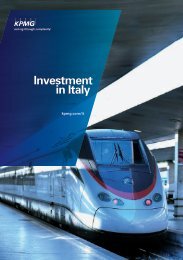Innovation Canada: A Call to Action
Innovation Canada: A Call to Action
Innovation Canada: A Call to Action
Create successful ePaper yourself
Turn your PDF publications into a flip-book with our unique Google optimized e-Paper software.
<strong>Innovation</strong> <strong>Canada</strong>: A <strong>Call</strong> <strong>to</strong> <strong>Action</strong>Getting ThereTo realize this vision, the government shouldincorporate the following practices in itsprocurement initiatives.3.1 <strong>Innovation</strong> as an objective — Make theencouragement of innovation in theCanadian economy a stated objective ofprocurement policies and programs.In practice, this broad recommendation requiresthe government <strong>to</strong> regard any significantacquisitions of goods and services asopportunities <strong>to</strong> build SME innovativecapabilities and thus <strong>to</strong> strengthen both thebase of suppliers for future procurement and,more generally, the innovation capacity of theCanadian economy. This will require thegovernment over time <strong>to</strong> undertake acomprehensive review of procurement policiesand activities <strong>to</strong> ensure that they are supportinginnovation and that departments have theflexibility <strong>to</strong> work with private sec<strong>to</strong>r solutionproviders and then acquire and deploy theresulting solutions. As first steps for action, thePanel further makes the followingrecommendations.3.2 Scope for innovative proposals —Wherever feasible and appropriate, baseprocurement requests for proposals on adescription of the needs <strong>to</strong> be met orproblems <strong>to</strong> be solved, rather than ondetailed technical specifications that leave<strong>to</strong>o little opportunity for innovativeproposals.The use of procurement <strong>to</strong> foster the innovationcapacity of Canadian companies requires arevised approach <strong>to</strong> value-for-money based onoutcomes-oriented specifications. Procuremen<strong>to</strong>n the basis of the outcomes desired sets achallenge for industry and thus motivatesinnovative solutions from potential suppliers.This has the dual benefit of bringing forwardbetter products for the buyer and developing aninnovation-focussed mindset in the suppliercommunities. The use of an outcome-orientedprocurement specification does not need <strong>to</strong> bean invariable rule, since there will be caseswhere more detailed technical specifications fora particular procurement would be clearlyappropriate and would not be inconsistent withthe intent of this recommendation.3.3 Demand-pull — Establish targets fordepartments and agencies for contractingout R&D expenditures, including asubtarget for SMEs, and evolve the currentpilot phase of the Canadian <strong>Innovation</strong>Commercialization Program (CICP) in<strong>to</strong> apermanent, larger program that solicitsand funds the development of solutions<strong>to</strong> specific departmental needs so that thegovernment stimulates demand for, andbecomes a first-time user of, innovativeproducts and technologies.Federal departments and agencies, includingthose of major industry relevance, such as theDepartment of National Defence, undertakemost non-regula<strong>to</strong>ry R&D internally. According <strong>to</strong>Statistics <strong>Canada</strong> (2010a), federal in-house R&Dis projected at $1.9 billion in 2010–11, whileR&D contracted <strong>to</strong> businesses is projected <strong>to</strong>amount <strong>to</strong> $272 million or only about15 percent of the in-house R&D <strong>to</strong>tal. More than80 percent of the amount of R&D contracted <strong>to</strong>businesses is accounted for by two agencies —the Canadian Space Agency at $167 millionand the Department of National Defence at$59 million. Setting specific department-bydepartmenttargets for external R&D contractswould promote business innovation whilepotentially improving outcomes for contractingdepartments and strengthening their ability <strong>to</strong>deliver on their mandates.The current CICP pilot is “supply-push” in thesense that the applicants submit proposals <strong>to</strong>provide innovative solutions for trial and testing,though not as responses <strong>to</strong> explicitly identifiedneeds of a particular department or agency(Box 7.2). A new pilot element is needed that7-4
















